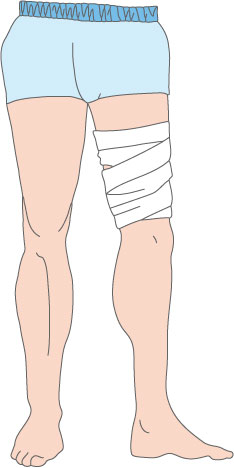Definition and causes of pulled muscle

Burst of muscle fibers called pulled, strained, torn or
ruptured muscle often occur during sport activity or
strenuous physical work and in particular if
the muscles have not been properly warmed up
before commencing the activity. An elastic bandage
can be supportive and alleviating.
When a muscle is pulled too far one or more fibers inside the muscle will rupture. This is called a pulled muscle, a strained muscle or a torn muscle. A case where the muscle is torn apart totally is called a muscle rupture. This is seen rarely, because it requires a lot of force, and consequently this condition is more serious.
A pulled or strained muscle with fiber damage is a very common condition which often occurs in sport, especially after insufficient warming up. Damage to muscle fibers may be seen also in other situations where the muscle is stretched too far. The older you get the greater is the risk of muscle injury by tear and strain.
Symptoms of pulled muscle
Cases of minor excessive strain may result in a pulled muscle. The condition rarely results in major symptoms and heals quickly when given rest.
However, if the muscle fibers burst, you will immediately feel a twinge in the muscle, and there will be pain. A bleed will occur in the muscle showing as a bruise on the skin. As the bleeding progresses the area will swell.
If a muscle fully ruptures the burst may be laudable and the pain can be very severe. A bulge will be visible in the area where the ruptured muscle has contracted.
Precautions
In sport, a thorough warming of the muscles is important. The warmer and more flexible muscles are, the less is the risk of a pulled muscle or worse muscle injury.
Persons with a tendency of muscle fiber damage can use elastic bandage or ointments that keep the muscles warm. The older you are, and the worse physical shape you are in, the more attention should be paid to avoid muscle injury.
Treatment of pulled muscles
Light muscle fiber and muscle strains are possible to treat yourself. There are four things that are important.
-
The area should have rest to convalesce.
-
An icepack will reduce bleeding and swelling, and can simultaneously relieve the pain. It is important not to put the icepack directly onto the skin, but to have a tea towel or similar between the icepack and the skin to avoid frost bite. The maximum duration use of an icepack is 20 minutes per hour. As long as there is pain when resting, ice may help.
-
Compression in the form of elastic bandage. This will reduce swelling. However, it is important not to compress too much, as compression, combined with internal bleeding, may increase pressure in the muscle and veins, arteries and nerves may become compressed. - See below about Compartment Syndrome
-
To prevent swelling, it is helpful to raise the damaged part above the hart position to minimize the blood supply to the damaged part which will alleviate the swelling and the pain
After a few days of rest, light rehabilitation can begin.
By major injuries your doctor may prescribe physiotherapy and longer periods of rest. It may be necessary to make use of crutches or an arm sling. Medication in the form of non-steroidal, anti-inflammatory drugs such as Voltaren, Ibuprufen, Ibumetin or Ipren can be taken to alleviate pain and swelling.
In cases of muscle rupture surgical treatment is needed.
Complications
If there is a major bleeding, pressure be in muscle tissue may become so large that veins, arteries and nerves are compressed. This is a serious condition called Compartment Syndrome which may require fasciatomy surgery to improve blood flow and ease the pressure. If this procedure is not performed the affected tissue might perish.
Læs denne artikel på dansk |